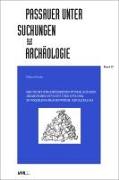- Start
- Die nicht stratifizierten Funde aus den Grabungen 1973-1975 und 1978-1982 in Wessling-Frauenwiese
Die nicht stratifizierten Funde aus den Grabungen 1973-1975 und 1978-1982 in Wessling-Frauenwiese
Angebote / Angebote:
Die Arbeit stellt den 2. Band [vgl. PUA 7] zur ca. 10.000 m² großen, 4-phasigen Siedlung dar. Die dortigen Ausgrabungen lieferten u. a. zahlreiche römisch-kaiserzeitliche Kleinfunde aus Metall, Keramik, Glas, Bein, Lavez und sonstigem Gestein, von denen nun auch die unstratifizierten, aber eingemessenen [Katalog I], die einem Grabungssektor näher zuzuweisenden [Katalog II] sowie die Altfunde aus einer Grube oder einem Brunnen nördlich des N-Tores [Katalog III] vorgelegt werden. Sie zeigen, daß die Siedlung ununterbrochen vom späten 1. bis weit ins 5. Jh. n.Chr. Bestand hatte. Die räumliche Streuung ausgewählter Fundgruppen der Kataloge I-II der mittleren bis späten Kaiserzeit wie Terra Sigillata, Rätische Ware, Reibschüsseln, Teller, Kolbenrandtöpfe und Lavezware sowie Neuzeitliche Ware ist auf acht Karten mit unterlegtem Bebauungsplan dargestellt. Dank seit 2003 andauernder Kiesgewinnung ist das weitgehend siedlungsleere Umfeld der Siedlung bestens bekannt und hat einen Brunnen, eine Feuerstelle und Einfriedungen von Wiesen/Feldern im Osten sowie Pfostenbauten, möglicherweise ein Gehöft aus Wohnhaus und zwei Nebengebäuden, im Nordosten ergeben.
The present study is the 2nd volume [cf. PUA 7] on this approximately 10, 000 m² large settlement with 4 phases. The excavations there yielded, among other things, numerous small Roman-Imperial finds of metal, pottery, glass, bone, soapstone, and other rocks, of which the ones unstratified but measured [Catalogue I], the ones that can be assigned more precisely to an excavation sector [Catalogue II], and the old finds from a pit or a well north of the north gate [Catalogue III] are now also presented. They show that the settlement existed without interruption from the late 1st to well into the 5th century A.D. The spatial distribution of selected find groups from catalogues I-II of the Middle to Late Imperial period, such as Terra sigillata, Rhaetian ware, mortaria, plates, pots with club-shaped rims, soapstone, as well as Early Modern ware, is plotted in 8 maps with a plan of buildings underneath. Thanks to ongoing gravel extraction since 2003, the largely unsettled surroundings of the settlement are well known and have revealed a well, a hearth, and enclosures of meadows/fields in the east as well as post buildings in the north-east, possibly from a farmstead including a house and two outbuildings.
Libri-Titel folgt in ca. 2 Arbeitstagen
